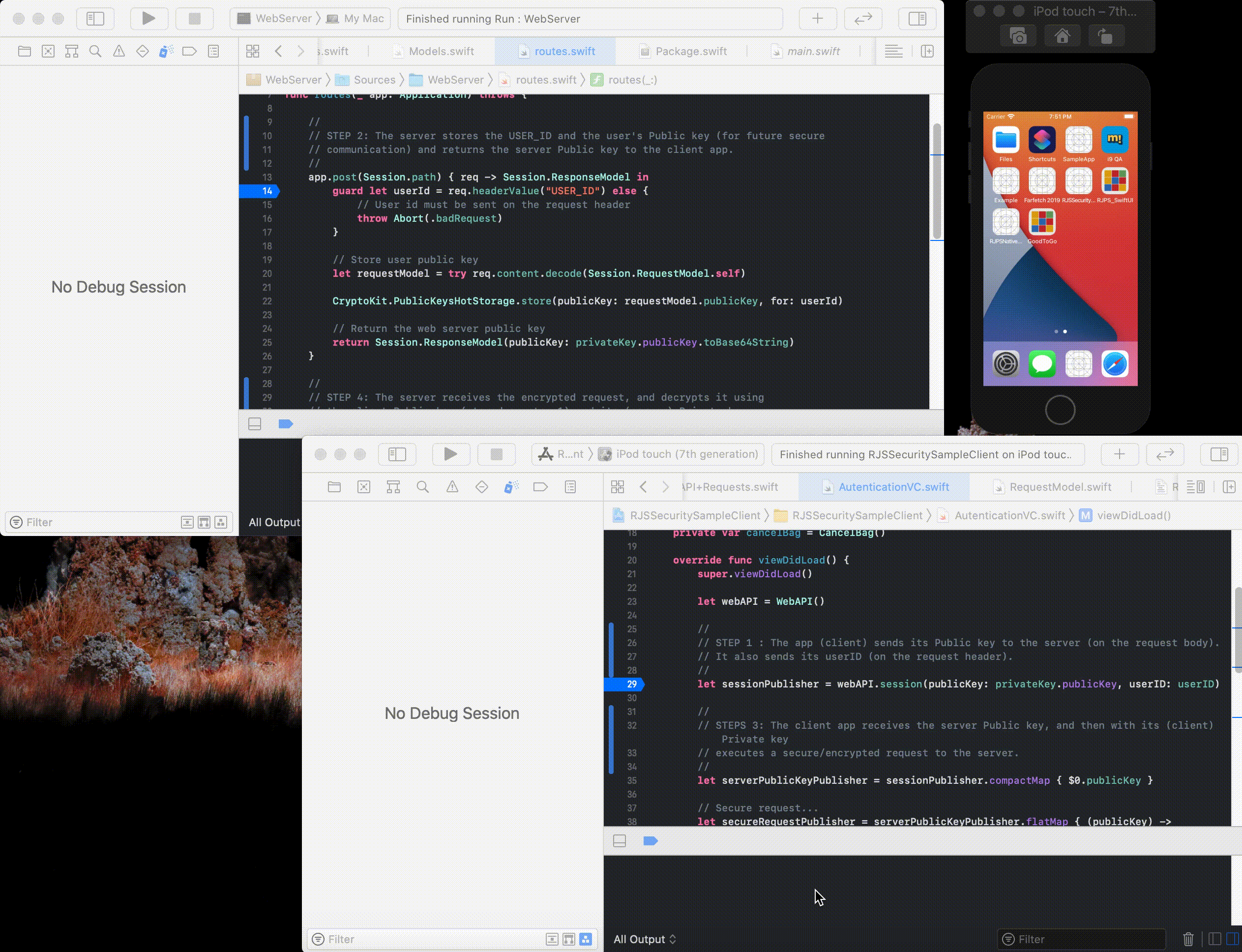Utilities framework and sample client app and web server providing end-to-end encrypted communication using Apple CryptoKit concepts.
struct AliceSender {
private init() { }
static let privateKey = CryptoKit.newPrivateKeyInstance()
static let publicKey = privateKey.publicKey
}
struct BobReceiver {
private init() { }
static let privateKey = CryptoKit.newPrivateKeyInstance()
static let publicKey = privateKey.publicKey
}
static let salt = "6beab91f-4a1a-4449-96cb-b6e0edb30776".data(using: .utf8)!
static let secretPlain = "my secret"
static let secretPlainData = CryptoKit.humanFriendlyPlainMessageToDataPlainMessage(secretPlain)!// Sender: Generating symmetric key and encrpting data USING shared symmetric key
let senderSymmetricKey = CryptoKit.generateSymmetricKeyBetween(AliceSender.privateKey, and: BobReceiver.publicKey, salt: salt)!
let encryptedData = CryptoKit.encrypt(data: secretPlainData, using: senderSymmetricKey)!
// Receiver: Generating symmetric key and decrypting data USING shared symmetric key
let reveiverSymmetricKey = CryptoKit.generateSymmetricKeyBetween(BobReceiver.privateKey, and: AliceSender.publicKey, salt: salt)!
let decryptedData = CryptoKit.decrypt(encryptedData: encryptedData, using: reveiverSymmetricKey)// Sender: Generating symmetric key and encrpting data USING public and private keys
let encryptedData = CryptoKit.encrypt(data: secretPlainData,
sender: AliceSender.privateKey,
receiver: BobReceiver.publicKey,
salt: salt)!
// Receiver: Generating symmetric key and decrypting data USING public and private keys
let decryptedData = CryptoKit.decrypt(encryptedData: encryptedData,
receiver: BobReceiver.privateKey,
sender: AliceSender.publicKey,
salt: salt)Inside the folders RJSecuritySampleClient and RJSecuritySampleServer a sample client app (Swift) and sample server web app (Vapor Swift) can be found. These applications are ready to use.
Both the client app and the server use the RJSP_Security lib installed via SPM and are a live working example of the key exchange process, followed by a secure communication.
Open both projects on Xcode
- Start the server.
- Start the app.
The project's sample flow is as follows:
Step 1 : The app (client) sends its public key to the server (on the request body). It also sends its userID (on the request header).
static func session(publicKey: Curve25519.KeyAgreement.PublicKey, userID: String) -> RequestModel {
let httpBody = [
"publicKey": CryptoKit.base64String(with: publicKey),
"userId": userID
]
return RequestModel(path: "session",
httpMethod: .post,
httpBody: httpBody,
userId: userID)
}let sessionPublisher = webAPI.session(publicKey: privateKey.publicKey, userID: userID)Step 2: The server stores the userID and the user's public key (for future secure communication) and returns the server public key to the client app.
app.post(Session.path) { req -> Session.ResponseModel in
guard let userId = req.headerValue("USER_ID") else {
// User id must be sent on the request header
throw Abort(.badRequest)
}
// Store user public key
let requestModel = try req.content.decode(Session.RequestModel.self)
CryptoKit.PublicKeysHotStorage.store(publicKey: requestModel.publicKey, for: userId)
// Return the web server public key
return Session.ResponseModel(publicKey: privateKey.publicKey.toBase64String)
}Step 3: The client app receives the server public key, and then with its (client) private key executes a secure/encrypted request to the server.
static func secure(encrypted: Data, userID: String) -> RequestModel {
let httpBody = ["secret": CryptoKit.encodeToSendOverNetwork(encrypted: encrypted)]
return RequestModel(path: "secureRequest",
httpMethod: .post,
httpBody: httpBody,
userId: userID)
}// Session response with server public key...
let serverPublicKeyPublisher = sessionPublisher.compactMap { $0.publicKey }
// Secure request...
let secureRequestPublisher = serverPublicKeyPublisher.flatMap { (publicKey) -> AnyPublisher<ResponseDto.SecureRequest, APIError> in
let plainHumanMessage = "Hi server. Can you uppercase me? \(Date())"
let serverPublicKey = CryptoKit.publicKey(with: publicKey)!
let plainDataMessage = CryptoKit.humanFriendlyPlainMessageToDataPlainMessage(plainHumanMessage)!
let encryptedMessage = CryptoKit.encrypt(data: plainDataMessage,
sender: privateKey,
receiver: serverPublicKey,
salt: sharedSalt)
return webAPI.secure(encrypted: encryptedMessage!, userID: userID)
}Step 4: The server receives the encrypted request, and decrypts it using the client public key (stored on step 1) and its (server) private key. After decrypting the message, the server just returns it as a "proof" of success.
app.post(SecureRequest.path) { req -> SecureRequest.ResponseModel in
guard let userId = req.headerValue("USER_ID"),
let clientPublicKey = CryptoKit.PublicKeysHotStorage.get(for: userId) else {
// User id must be sent on header and
// the server must know the user public key allready
throw Abort(.badRequest)
}
let requestModel = try req.content.decode(SecureRequest.RequestModel.self)
let encryptedData = requestModel.secretData
guard let decryptData = CryptoKit.decrypt(encryptedData: encryptedData!,
receiver: privateKey,
sender: clientPublicKey,
salt: sharedSalt!) else {
throw Abort(.notAcceptable)
}
// Decode the secret message
let humanFriendlyPlainMessage = CryptoKit.dataPlainMessageToHumanFriendlyPlainMessage(decryptData)!
let message = "Sure!\n\n\(humanFriendlyPlainMessage.uppercased())"
return SecureRequest.ResponseModel(message: message)
}




